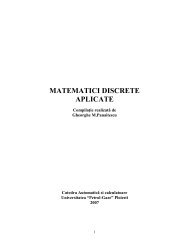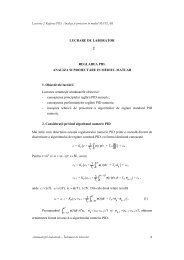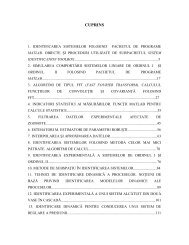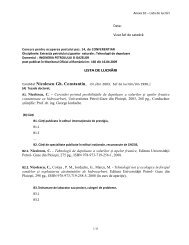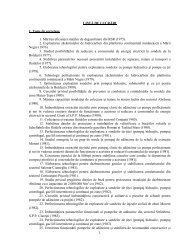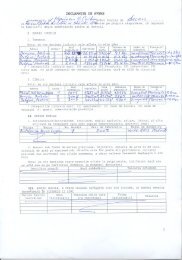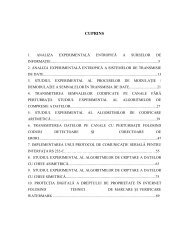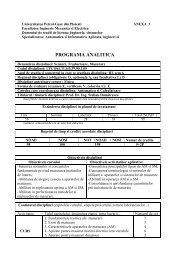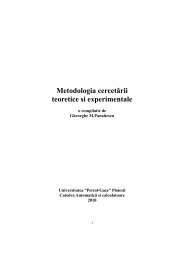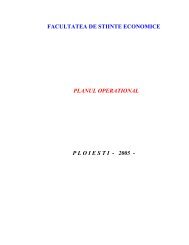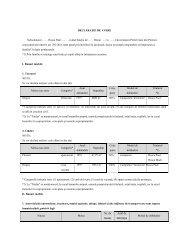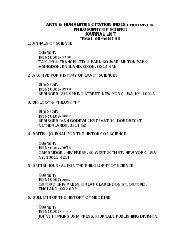Note de curs - Departamentul Automatica, Calculatoare si ...
Note de curs - Departamentul Automatica, Calculatoare si ...
Note de curs - Departamentul Automatica, Calculatoare si ...
Create successful ePaper yourself
Turn your PDF publications into a flip-book with our unique Google optimized e-Paper software.
DFR – Decrea<strong>si</strong>ng Failure Rate – ratǎ <strong>de</strong> <strong>de</strong>fectare <strong>de</strong>screscǎtoare<br />
Aceste calificative sunt în relatia IFR ⇒ IFRA, DFR ⇒ DFRA. Implicatiile nu<br />
sunt valabile <strong>si</strong> invers.<br />
Demonstratie. Dacǎ un <strong>si</strong>stem este IFR atunci functia ln[1/R(t)] este convexǎ<br />
t<br />
′<br />
″<br />
1<br />
⎛ 1 ⎞<br />
⎛ 1 ⎞<br />
ln = ( ) ln ( ) ⎜ ln ⎟ = ′(<br />
) > 0<br />
( )<br />
∫ z u du ⇒ ⎜<br />
⎟ = z t ⇒<br />
z t<br />
R t<br />
( )<br />
( )<br />
0<br />
⎝ R t ⎠<br />
⎝ R t ⎠<br />
<strong>de</strong>rivata unei functii convexe pozitive care trece prin origine este crescǎtoare pe<br />
intervalul (0, ∞) <strong>si</strong> atunci se poate afirma cǎ functia<br />
1 1<br />
ln − ln<br />
R ( t ) R ( 0 )<br />
t<br />
este crescǎtoare pe acela<strong>si</strong> interval. Acela<strong>si</strong> mers al <strong>de</strong>monstratiei pentru DFR<br />
tinând seama <strong>de</strong> concavitatea functiei ln[1/R(t)].<br />
În ipoteza cǎ functia ln[1/R(t)] nu este <strong>de</strong>rivabilǎ, <strong>de</strong> pildǎ în cazul <strong>si</strong>stemelor<br />
cu ratǎ <strong>de</strong> <strong>de</strong>fectare constantǎ pe portiuni, implicatiile <strong>de</strong> mai sus rǎmân<br />
valabile.<br />
Sistemele cu <strong>de</strong>gradare sunt <strong>si</strong>steme pentru care functia <strong>de</strong> fiabilitate relativǎ<br />
la o utilizare <strong>de</strong> duratǎ x care începe la momentul t este mai micǎ <strong>de</strong>cât functia<br />
<strong>de</strong> fiabilitate pentru intervalul (0, x) oricare ar fi vârsta t <strong>si</strong> oricare ar fi durata x<br />
R( t, t + x) < R( x), t,<br />
x > 0<br />
cu alte cuvinte, dupǎ utilizare un asemenea <strong>si</strong>stem este inferior unuia nou (NBU<br />
– New Better than Used. Un <strong>si</strong>stem IFR este NBU dar nu tot<strong>de</strong>auna <strong>si</strong> invers<br />
(exercitiu).<br />
Se poate vorbi <strong>si</strong> <strong>de</strong> <strong>si</strong>steme fǎrǎ <strong>de</strong>gradare (NWU – New Worse than Used),<br />
pentru care<br />
R( t, t + x) > R( x), t,<br />
x > 0<br />
cu implicatia DFR ⇒ NWU dar nu <strong>si</strong> reciproc.<br />
Asadar calitǎtile NBU (NWU) sunt mai generale <strong>de</strong>cât IFR (DFR) <strong>si</strong> chiar <strong>de</strong>cât<br />
IFRA (DFRA). Ultima afirmatie se sustine prin <strong>de</strong>monstratia care urmeazǎ.<br />
Prin <strong>de</strong>finitie un <strong>si</strong>stem IFRA are functia ( 1/ t)ln( 1/ R ) crescǎtoare <strong>si</strong>, implicit,<br />
1<br />
[ 1/ R] / t 1<br />
crescǎtoare <strong>si</strong> [ R( t)] / t<br />
<strong>de</strong>screscǎtoare. Se poate scrie atunci<br />
<strong>si</strong> apoi<br />
1 1<br />
t + x t<br />
[ R( t + x)] < [ R( t)]<br />
R( t, t + x) < [ R( t)] t<br />
<strong>de</strong>oarece R(t, t + x) = R(t + x)/R(t).<br />
Pentru un x ∈ [ 0 , t]<br />
are loc<br />
1 1<br />
t<br />
x<br />
[ R( t)] ≤ [ R( x)]<br />
<strong>si</strong> apoi, tinând seamǎ <strong>de</strong> relatia anterioarǎ, rezultǎ<br />
1<br />
.<br />
x x<br />
R( t, t + x) < [ R( x)] = R( x)<br />
x<br />
29



